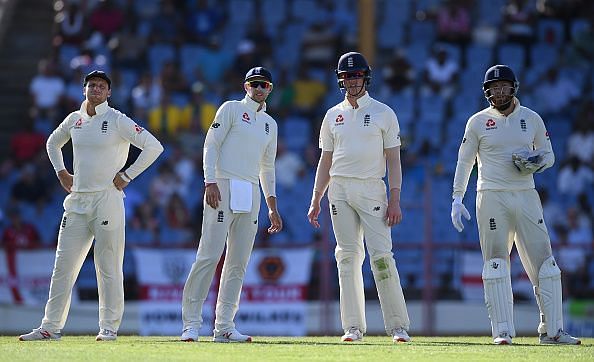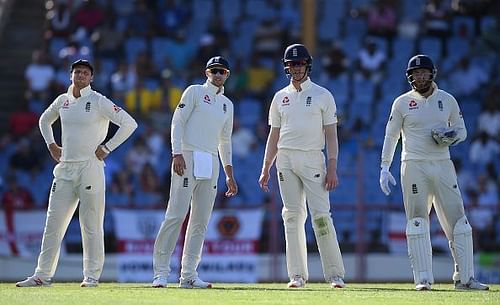
West Indies vs England 2019: Analyzing England's bizarre team selections

"When you select bits and pieces players, success also comes in bits and pieces," goes the popular saying.
It's rather astonishing that England, despite being the originators of the game of cricket, have never ruled world cricket like the West Indies or Australia. They have had their reasons, of course, and now they have found another reason for disappointment.
England recently became the first non-Asian team to whitewash Sri Lanka on home soil since 2004. Immediately after this high point though, Joe Root and his men experienced an embarrassing series defeat at the hands of the Windies.
England are a powerhouse of all-rounders. Ben Stokes, Chris Woakes, Sam Curran, David Willey and many others have played crucial roles for the team with both bat and ball in recent times. Perhaps the management gets too carried away by the success of its all-rounders.
Good teams always believe in taking the field with 4 or 5 genuine bowlers, and they back their top 6 batsmen to do the scoring. Teams may play 8 batsmen and score 600 runs, but if they fail to pick up 20 wickets or fail to pick them in time, they cannot win the match.
This basic principle seems alien to the English team management. That was quite evident when they left out Stuart Broad for Sam Curran in the first Test against the Windies. Their explanation was that he could give them some handy runs lower down the order, in addition to being the frontline seamer alongside James Anderson.
This was a bizarre decision, to say the least. England played Curran at No. 9. You want your genuine bowler at No. 9, and not a player who is still a work-in-progress towards becoming a genuine all-rounder.
In fact, at this stage of his career, Curran is quite one-dimensional. It's only when the ball swings a little bit, does he look effective.
Joe Root is a part of the "Fab 4" list containing Steven Smith, Virat Kohli and Kane Williamson. He averaged over 56 in Test cricket before 2018. However, that fell below 49 in the second Test against the Windies. This shows a significant dip in his performances, and he is regarded as the best batsman of the English lineup, the team has suffered accordingly.
If you are failing to find a good number three, you would probably want your best batsman to take up that challenge. However, Root has resisted batting at number 3 despite not being consistent at number 4 either, the position that he favours. Consequently, they have had to try Moeen Ali at number 3, which as expected did not work out.
Jonny Bairstow was constantly staying leg-side of the ball in the series against India. He exposed his off-stump in the process, and this weakness of his was exploited by the Indians.
Bairstow then made an improvement and took an off-stump guard, which allowed him to score a quickfire fifty in tough conditions against the Windies in the second Test - where he batted at number 3. However, for some reason, England changed Bairstow's batting position again in the third Test.
This number 3 paradox is seriously hurting England.
Moreover, ever since the retirement of Andrew Strauss, England have failed to find a stable opening partner for Alastair Cook. With Cook also retiring, the problems have worsened even further.
Keaton Jennings has already been given a long rope, but he hasn't given any confidence to the management. The county cricket circuit in England is not producing quality top order batsmen; with the spicy pitches being prepared, a lot of batsmen want to bat lower down the order. So top-order selections remain a big headache for England.
Adil Rashid, who had retired from red-ball cricket before the India series, sufficiently impressed Ed Smith, the chairman of selectors for England, with his white ball performances. Consequently, he was forced back into the Test team.
That was another confusing decision as Rashid's performances thereafter appropriately justified his retirement from red-ball cricket.
England's one-dimensional pace attack, with no bowler who has serious pace, is a concern. Even the great Anderson and Broad don't look effective when the conditions are not in their favour. Mark Wood gave them a sigh of relief with his performance in the third Test against the Windies, but there is still a long way to go.
Ben Foakes, who impressed in the series against Sri Lanka, was also dropped on the basis of just a couple of bad performances in the Carribean.
There is no denying the fact that the 4-1 scoreline against India was flattering. Even in Sri Lanka, they probably faced the weakest Sri Lankan team in the last two or three decades. It goes without saying then that the captain Root has his task cut out.
However, Root sometimes gives the impression that he doesn't command enough authority in the team, especially with senior players like Anderson and Broad. Perhaps he's just not a true leader like Virat Kohli.
England need to sort out a batting order and try to be consistent with that. They must back their batsmen to do the job rather than playing "bits and pieces players". If they aim to become the number 1 test team again, the current strategy does a lot of alterations.